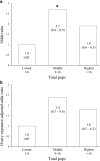Exceptional longevity in female Rottweiler dogs is not encumbered by investment in reproduction
- PMID: 23584889
- PMCID: PMC3825016
- DOI: 10.1007/s11357-013-9529-8
Exceptional longevity in female Rottweiler dogs is not encumbered by investment in reproduction
Abstract
To better understand the potential trade-off between female reproductive investment and longevity in an emerging model of human healthspan, we studied pet dogs to determine whether intensity of reproduction (total number of offspring) encumbered the likelihood of exceptional longevity. This hypothesis was tested by collecting and analyzing lifetime medical histories, including complete reproductive histories, for a cohort of canine "centenarians"--exceptionally long-lived Rottweiler dogs that lived more than 30% longer than the breed's average life expectancy. Reproductive intensity (number of litters, total number of pups) and tempo of reproductive effort (age at first reproduction, mean interbirth interval, age at last reproduction) in 78 exceptionally long-lived female Rottweilers (>13 years old) were compared to a cohort of 97 female Rottweilers that had usual longevity (age at death 8.0-10.75 years). We found no evidence that a mother's physiological investment in offspring was associated with disadvantaged longevity. Instead, similar to some studies in women, our data showed an inverted U-shaped trend, suggesting that moderate investment in reproduction may promote longevity. Late reproductive success, a much-studied surrogate of maternal fitness in women, was not a strong predictor of longevity in this canine cohort. Instead, independent of reproductive investment, the duration of lifetime ovary exposure was significantly associated with highly successful aging. Our results from exceptionally long-lived pet dogs provide rationale for further investigative efforts to understand the ovary-sensitive biological factors that promote healthy longevity in women and pet dogs.
Figures



References
-
- Gagnon A, Smith KR, Tremblay M, Vézina H, Paré P-P, Desjardins B. Is there a trade-off between fertility and longevity? A comparative study of women from three large historical databases accounting for mortality selection. Am J Human Biol. 2009;21:533–540. doi: 10.1002/ajhb.20893. - DOI - PMC - PubMed
Publication types
MeSH terms
LinkOut - more resources
Full Text Sources
Other Literature Sources
Medical
